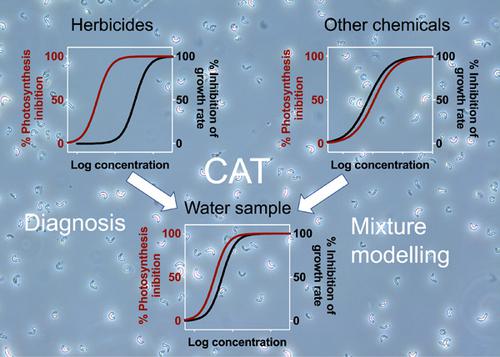当前位置:
X-MOL 学术
›
Environ. Toxicol. Chem.
›
论文详情
Our official English website, www.x-mol.net, welcomes your feedback! (Note: you will need to create a separate account there.)
The Combined Algae Test for the Evaluation of Mixture Toxicity in Environmental Samples.
Environmental Toxicology and Chemistry ( IF 4.1 ) Pub Date : 2020-09-14 , DOI: 10.1002/etc.4873 Lisa Glauch 1 , Beate I Escher 1, 2
Environmental Toxicology and Chemistry ( IF 4.1 ) Pub Date : 2020-09-14 , DOI: 10.1002/etc.4873 Lisa Glauch 1 , Beate I Escher 1, 2
Affiliation

|
The combined algae test is a 96‐well plate‐based algal toxicity assay with the green algae Raphidocelis subcapitata that combines inhibition of 24‐h population growth rate with inhibition of photosynthesis detected after 2 and 24 h with pulse‐amplitude modulated (PAM) fluorometry using a Maxi‐Imaging PAM. The combined algae test has been in use for more than a decade but has had limitations due to incompatibilities of the measurements of the 2 biological endpoints on the same microtiter plates. These limitations could be overcome by increasing growth rates and doubling times on black, clear‐bottom 96‐well plates by application of dichromatic red/blue light‐emitting diode illumination. Different robotic dosing approaches and additional data evaluation methods helped to further expand the applicability domain of the assay. The combined algae test differentiates between nonspecifically acting compounds and photosynthesis inhibitors, such as photosystem II (PSII) herbicides. The PSII herbicides acted immediately on photosynthesis and showed growth rate inhibition at higher concentrations. If growth was a similar or more sensitive endpoint than photosynthesis inhibition, this was an indication that the tested chemical acted nonspecifically or that a mixture or a water sample was dominated by chemicals other than PSII herbicides acting on algal growth. We fingerprinted the effects of 45 chemicals on photosynthesis inhibition and growth rate and related the effects of the single compounds to designed mixtures of these chemicals detected in water samples and to the effects directly measured in water samples. Most of the observed effects in the water samples could be explained by known photosystem II inhibitors such as triazines and phenylurea herbicides. The improved setup of the combined algae test gave results consistent with those of the previous method but has lower costs, higher throughput, and higher precision. Environ Toxicol Chem 2020;39:2496–2508. © 2020 The Authors. Environmental Toxicology and Chemistry published by Wiley Periodicals LLC on behalf of SETAC.
中文翻译:

联合藻类测试,用于评估环境样品中的混合物毒性。
组合藻类测试是一种基于96孔板的藻类毒性试验,其中包括绿藻Raphidocelis subcapitata结合了使用Maxi-Imaging PAM对脉冲宽度调制(PAM)荧光检测法在2和24 h后检测到的对24 h种群生长速率的抑制与对光合作用的抑制。组合藻类测试已经使用了十多年,但是由于在同一微量滴定板上对两个生物学终点的测量不兼容而受到限制。通过使用双色红色/蓝色发光二极管照明,可以在黑色,透明底部96孔板上增加生长速度和使时间加倍,从而克服这些限制。不同的机器人定量给药方法和其他数据评估方法有助于进一步扩展测定的适用范围。组合藻类测试区分了非特异性作用化合物和光合作用抑制剂,例如光系统II(PSII)除草剂。PSII除草剂立即作用于光合作用,并在较高浓度下显示出生长速率抑制作用。如果生长是比光合作用抑制更相似或更敏感的终点,则表明所测试的化学物质具有非特异性作用,或者混合物或水样中有除藻类生长以外的PSII除草剂以外的化学物质。我们对45种化学物质对光合作用抑制和生长速率的影响进行了指纹分析,并将单一化合物的影响与在水样品中检测到的这些化学物质的设计混合物以及在水样品中直接测量的影响相关。在水样中观察到的大多数影响可以用已知的光系统II抑制剂(例如三嗪和苯脲除草剂)解释。Environ Toxicol Chem 2020; 39:2496-2508。©2020作者。Wiley Periodicals LLC代表SETAC发布的《环境毒理学和化学》。
更新日期:2020-09-14
中文翻译:

联合藻类测试,用于评估环境样品中的混合物毒性。
组合藻类测试是一种基于96孔板的藻类毒性试验,其中包括绿藻Raphidocelis subcapitata结合了使用Maxi-Imaging PAM对脉冲宽度调制(PAM)荧光检测法在2和24 h后检测到的对24 h种群生长速率的抑制与对光合作用的抑制。组合藻类测试已经使用了十多年,但是由于在同一微量滴定板上对两个生物学终点的测量不兼容而受到限制。通过使用双色红色/蓝色发光二极管照明,可以在黑色,透明底部96孔板上增加生长速度和使时间加倍,从而克服这些限制。不同的机器人定量给药方法和其他数据评估方法有助于进一步扩展测定的适用范围。组合藻类测试区分了非特异性作用化合物和光合作用抑制剂,例如光系统II(PSII)除草剂。PSII除草剂立即作用于光合作用,并在较高浓度下显示出生长速率抑制作用。如果生长是比光合作用抑制更相似或更敏感的终点,则表明所测试的化学物质具有非特异性作用,或者混合物或水样中有除藻类生长以外的PSII除草剂以外的化学物质。我们对45种化学物质对光合作用抑制和生长速率的影响进行了指纹分析,并将单一化合物的影响与在水样品中检测到的这些化学物质的设计混合物以及在水样品中直接测量的影响相关。在水样中观察到的大多数影响可以用已知的光系统II抑制剂(例如三嗪和苯脲除草剂)解释。Environ Toxicol Chem 2020; 39:2496-2508。©2020作者。Wiley Periodicals LLC代表SETAC发布的《环境毒理学和化学》。



























 京公网安备 11010802027423号
京公网安备 11010802027423号